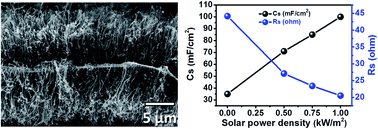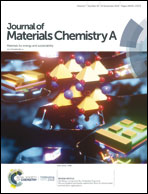Three-dimensional seamless graphene/carbon nanotube hybrids for multifunctional energy storage†
Abstract
Graphene and carbon nanotubes (CNTs) have been widely used as electrode materials for electrochemical energy storage devices (e.g., supercapacitors), but often result in limited performance because of their serious aggregation. To address the aforementioned crucial issue, herein, a three-dimensional seamless graphene/carbon nanotubes (G/CNTs) hybrid was fabricated by directly growing aligned CNTs arrays from the surface of graphene in foam, during which a simpler solution approach with low energy consumption was used to coat the catalyst for growth of CNTs, replacing conventional electron-beam vapor deposition. By using the seamless G/CNTs hybrids as electrodes, two-electrode solid-state multifunctional supercapacitors have been developed. Due to the excellent photo-conductive effect of graphene and CNTs, the capacitance of the obtained supercapacitor increased by 1.9 times under one solar light illumination (1.0 kW m−2), compared with that of the device in the dark. The specific capacitance of supercapacitors could be further improved by incorporating a conducting polymer of polyaniline in G/CNTs hybrids. Furthermore, the newly developed supercapacitors can well maintain their original capacitance as they were bent to any angle and stretched to a strain of 240%, indicating excellent flexibility and stretchability. The unique three-dimensional seamless G/CNTs hybrids are also promising to be used for building other multifunctional electronic devices beyond energy storage.



 Please wait while we load your content...
Please wait while we load your content...